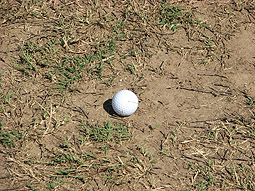On The Road With The USGA
 |
|
| The combination of drought, winter temperatures, and spring traffic adds up to poor turf quality on common bermudagrass. |
Winter
The winter of 2007 - 2008 was set for a major winterkill throughout the region. Bermudagrass was under stress in drought stricken areas and when it went to bed in late fall, it was in a weakened state. Fortunately, temperatures cold enough to inflict serious injury never arrived. With that said, we did see our fair share of poor common bermudagrass. It seems the common was particularly hard hit through the drought and winter. When exposed to traffic in the spring, it was beaten down into submission and an unacceptable playing surface resulted. Most of it came back, although it took until well into July before it proved to be acceptable for golf.
Spring
Superintendents were enthusiastic about the return of warm temperatures and the opportunity to begin cultural practices on warm season grasses after several months of dormancy. Rainfall totals returned to near normal in much of the region. Temperatures in April were ideal for bentgrass growth and recovery from spring aeration. Bentgrass putting greens by and large had a fantastic spring for growth and playing conditions reflected this good weather. Overseeding transitions progressed predictably in late May and June.
Summer
July typically kicks off the summer stress period for bentgrass putting greens in the Southeast. The advent of improved fungicides and other life support tools is helping most superintendents keep their bentgrass putting greens in good shape. In early July, many parts of the region began experiencing afternoon thunderstorms for multiple days in a row. While this is helpful in keeping reservoirs and ponds full, this is not good for bentgrass putting greens. Only time will tell how bentgrass greens perform for the rest of the summer.
Commodity Prices
A major story affecting everyone in golf this year has been the increase in commodity prices. Everything from fertilizer, fuel, herbicides, sand, and anything going into the clubhouse has increased in price. We are not talking about normal 3-4% inflation driven increases, either. Certain plant nutrients have spiked in price by as much as 50 to 100%. All of this is occurring while our customers (golfers) are paying $4 a gallon to get to the golf course. For a leisure activity like golf, these trends are troublesome.
Saving Money or Cost Cutting
A popular topic in the 1990's on Turf Advisory Visits was raising the bar on playing conditions through increases in operating budgets. We have not heard this phrase in many years. It has been replaced with a desire to find the fewest amount of resources necessary to produce the desired standard. This is a way to save money and stretch the budget dollars a little farther. It should not be confused with cost cutting.
Cost cutting in golf course maintenance must go hand in hand with lower expectations. This is a simple concept, but many golfers and country club members are not getting the message.
Let's use an example to illustrate this point. A superintendent at a private club is asked to cut his budget by 10%. Typically, this means there will be fewer employees and there will be less money to buy fertilizers, herbicides, and other supplies. Will this alter the product created for the golfers? Yes. Are golfers aware and accepting of lower quality playing conditions? We say the answer is no for a couple of reasons. First, most golf courses do not operate with any type of concrete maintenance standards. They operate under a loose standard of "we try to create the best product for the amount of money we have". This system works well when budgets creep upward over time slightly faster than the rate of inflation because there are incremental improvements in quality. Second, communications regarding budgets and expectations rarely filter down to the golfer.
As more golf courses are faced with cost cutting, communication will be more important than ever. If standards must be lowered, it is better to get the news out sooner rather than letting them be a surprise to golfers. If market conditions require your golf course to save money or cut costs, we can help you with the process and communicating the implications to owners or members. We see hundreds of courses a year and we are always "PowerPoint" ready for meetings. Give us a call or email: Patrick O'Brien ( patobrien@usga.org 678-591-7340) or Chris Hartwiger ( chartwiger@usga.org or 678-591-7410).
